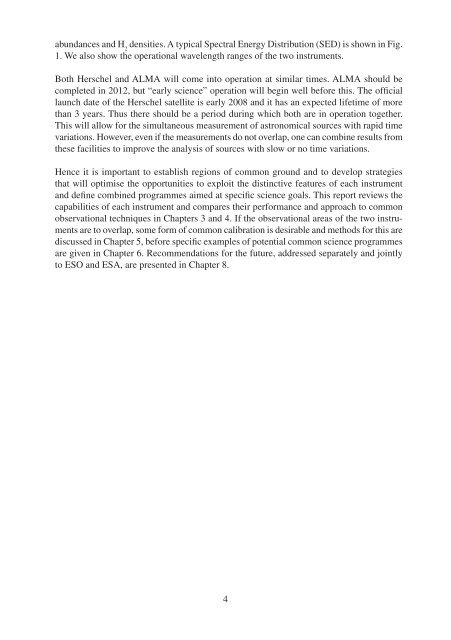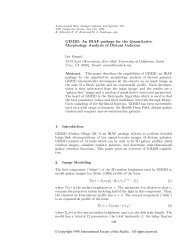4 Comparison of the ALMA and Herschel - ESO
4 Comparison of the ALMA and Herschel - ESO
4 Comparison of the ALMA and Herschel - ESO
You also want an ePaper? Increase the reach of your titles
YUMPU automatically turns print PDFs into web optimized ePapers that Google loves.
abundances <strong>and</strong> H 2<br />
densities. A typical Spectral Energy Distribution (SED) is shown in Fig.<br />
1. We also show <strong>the</strong> operational wavelength ranges <strong>of</strong> <strong>the</strong> two instruments.<br />
Both <strong>Herschel</strong> <strong>and</strong> <strong>ALMA</strong> will come into operation at similar times. <strong>ALMA</strong> should be<br />
completed in 2012, but “early science” operation will begin well before this. The <strong>of</strong>ficial<br />
launch date <strong>of</strong> <strong>the</strong> <strong>Herschel</strong> satellite is early 2008 <strong>and</strong> it has an expected lifetime <strong>of</strong> more<br />
than 3 years. Thus <strong>the</strong>re should be a period during which both are in operation toge<strong>the</strong>r.<br />
This will allow for <strong>the</strong> simultaneous measurement <strong>of</strong> astronomical sources with rapid time<br />
variations. However, even if <strong>the</strong> measurements do not overlap, one can combine results from<br />
<strong>the</strong>se facilities to improve <strong>the</strong> analysis <strong>of</strong> sources with slow or no time variations.<br />
Hence it is important to establish regions <strong>of</strong> common ground <strong>and</strong> to develop strategies<br />
that will optimise <strong>the</strong> opportunities to exploit <strong>the</strong> distinctive features <strong>of</strong> each instrument<br />
<strong>and</strong> define combined programmes aimed at specific science goals. This report reviews <strong>the</strong><br />
capabilities <strong>of</strong> each instrument <strong>and</strong> compares <strong>the</strong>ir performance <strong>and</strong> approach to common<br />
observational techniques in Chapters 3 <strong>and</strong> 4. If <strong>the</strong> observational areas <strong>of</strong> <strong>the</strong> two instruments<br />
are to overlap, some form <strong>of</strong> common calibration is desirable <strong>and</strong> methods for this are<br />
discussed in Chapter 5, before specific examples <strong>of</strong> potential common science programmes<br />
are given in Chapter 6. Recommendations for <strong>the</strong> future, addressed separately <strong>and</strong> jointly<br />
to <strong>ESO</strong> <strong>and</strong> ESA, are presented in Chapter 8.<br />
4




